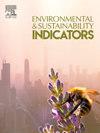本地可持续发展的标杆:新西兰葡萄园的能源和水使用案例
IF 5.4
Q1 ENVIRONMENTAL SCIENCES
引用次数: 0
摘要
可持续发展基准是将绩效指标与其他组织进行比较,以确定、适应和实施可持续发展改进的最佳实践方法的过程。如果以公平合理的比较为基础,适应当地生物物理和经济限制等特点,以便将所有农民置于“公平竞争的环境”,基准制定过程就更有可能激励和指导可持续实践。本研究开发了一个基准理论,以适应当地的机会和限制,有效地激励当地调整的可持续性改进。这是通过分析参与新西兰可持续葡萄酒种植计划的1103个葡萄园的能源和水资源使用情况来实现的。预测能源和水利用时空变化的回归模型解释了相对较大比例的资源利用变化。生产区域和生产区域是资源效率的共同和显著的预测因子。随着时间的推移,葡萄园的燃油效率提高了59%,推动了节能计划和行动。当在整个部门内或在其他同等特征的葡萄园内进行基准测试时,葡萄园的排名表现差异很大,特别是影响绩效的农业生态和生产相关特征。例如,一个葡萄园的燃油效率在该行业中排名20%,但与自己所在地区和类似产区的葡萄园相比,却达到了75%。汇总和非地方调整的基准可能最适合消费者和国家一级的政策制定者,但它们没有捕捉到个别农民面临的地方和多样化的挑战。使用本地调整的基准方法可以更好地确定实际的可持续发展改进机会,并可能增强农民对可持续发展工作的信任,提高参与度,更好地激励向可持续发展转变。本文章由计算机程序翻译,如有差异,请以英文原文为准。
Benchmarking for locally tuned sustainability: The case of energy and water use in New Zealand vineyards
Sustainability benchmarking is the process of comparing indicators of performance with other organizations to identify, adapt and implement best practice approaches for sustainability improvement. The benchmarking process is more likely to incentivise and guide sustainable practice if it is based on fair and sensible comparisons, accommodating features such as local biophysical and economic constraints, in order to place all farmers on a “level playing field”. This study developed a benchmarking rationale accommodating local opportunities and constraints for effectively incentivising locally-tuned sustainability improvements. This was carried out by analysing energy and water use on the 1103 vineyards enrolled in the Sustainable Wine-growing New Zealand scheme. Regression models to predict spatial and temporal variations of energy and water use explained relatively large proportions of the resource use variance. Production area and region were common and significant predictors of resource efficiency. A 59% increase over time in fuel efficiency took place in vineyards instigating energy reduction plans and actions. The vineyards' rank performance differed widely when benchmarked within the entire sector or within other vineyards of equivalent characteristics, specifically for agroecological and production related characteristics influencing performance. For example, one vineyard ranked at the 20 percentile in fuel efficiency within the sector, yet at the 75 percentile when compared against vineyards in its own region and with a similar production area. Aggregated and non-locally tuned benchmarking might best suit consumers and national-level policy makers, but they do not capture the local and diverse challenges faced by the individual farmers. Use of locally-tuned benchmarking approaches can better identify actual sustainability improvement opportunities and may enhance farmers’ trust in the sustainability exercise, improve participation and better incentivise change towards sustainability.
求助全文
通过发布文献求助,成功后即可免费获取论文全文。
去求助
来源期刊

Environmental and Sustainability Indicators
Environmental Science-Environmental Science (miscellaneous)
CiteScore
7.80
自引率
2.30%
发文量
49
审稿时长
57 days
 求助内容:
求助内容: 应助结果提醒方式:
应助结果提醒方式:


